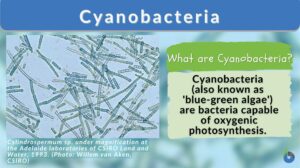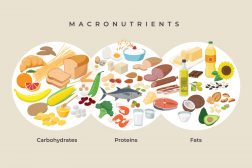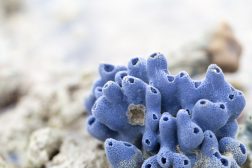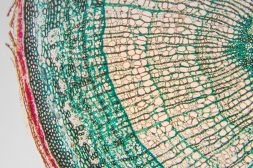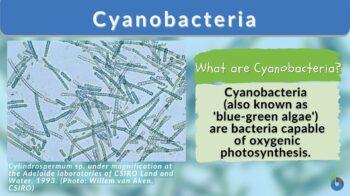
Cyanobacteria
n., singular: cyanobacterium
[ˈsaɪ əˌnoʊ bækˈtɪɹ.i.ə]
Definition: photosynthetic bacteria, also known as the blue-green algae
Table of Contents
Cyanobacteria Definition
Cyanobacteria is a group of photosynthetic bacteria widely distributed in various aquatic habitats (oceans, seas, rivers, lakes, etc.) and terrestrial habitats (e.g. moist soils). They may live singly or in colonies (by forming filaments or spheres with other cyanobacteria). Cyanobacteria are important oxygen producers of the planet.
They are one of the oldest life forms on Earth together with the other early prokaryotes. They existed billions of years ago in the early extreme environments before plants and animals emerged.
The oldest known fossils are the stromatolites, which apparently formed as mounds of biofilms of microorganisms, such as cyanobacteria and other algal material. These fossil remains are found in the Archaean rocks of western Australia and they are dated 3.5 billion years old. (Baumgartner, 2019)
Early cyanobacteria play a role in the Great Oxygenation Event by releasing oxygen as a byproduct of photosynthesis. Moreover, according to the Endosymbiotic theory, they formed symbiotic associations with other organisms where they participated as endosymbionts of larger primitive host cells. Eventually, the endosymbiont cyanobacteria turned into plastids of the photosynthetic eukaryotic cells of today.
Presently, some cyanobacterial species still live closely as endosymbionts of certain eukaryotes. An example of this is the nitrogen-fixing cyanobacteria. Most cyanobacteria, though, are living freely in nature.
Etymology: The term cyanobacteria came from the Greek kyanós, meaning “blue” and bacteria. Synonyms: Myxophyceae (Wallroth, 1833); Phycochromaceae (Rabenhorst, 1865); Cyanophyceae (Sachs, 1874); Schizophyceae (Cohn, 1879); Cyanophyta (Steinecke, 1931); Oxyphotobacteria (Gibbons & Murray, 1978).
General Characteristics
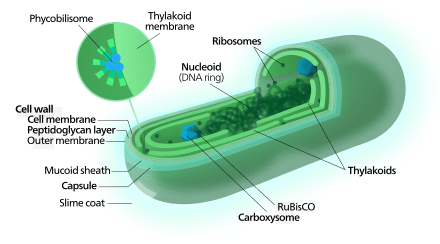
Cyanobacteria are a polyphyletic group, meaning they have different ancestral lines. However, they have traits that are common among them. Here are some typical characteristics shared by many species of cyanobacteria:
-
Prokaryotic cells
This characteristic is shared by all Cyanobacteria. They are prokaryotic, meaning they lack a membrane-bound nucleus, which is a fundamental feature of a prokaryote.
-
Photoautotrophs
Cyanobacteria are the earliest cells capable of harnessing solar energy to drive their own food synthesis.
-
Cell wall
Cyanobacteria have a cell wall comprised mainly of peptidoglycan on its inner wall and lipopolysaccharides on the outer wall. On the outermost surface of the outer wall is a layer of fibrous material.
-
Blue-green color
Cyanobacteria are characterized by the presence of pigments that account for their color. In fact, they got their name ‘Cyanobacteria’ from their color, cyan (which is greenish blue).
-
Pigments
Phycobilisomes are pigments responsible for the blue-green pigmentation of most cyanobacteria. Other pigments are chlorophyll. These photosynthetic pigments enable them to synthesize their own sugar through photosynthesis.
Some cyanobacterial species (e.g. Prochlorothrix, Prochlorococcus, Prochloron) lack phycobilisomes but they have chlorophyll b.
-
Photosynthetic machinery
Phycobilisomes are embedded in the intracytoplasmic membranes (thylakoids). The phycobiliproteins are components of the phycobilisomes (light-harvesting antennae for cyanobacterial photosystems).
-
Thylakoids – for photosynthesis and cellular respiration
The thylakoids of cyanobacteria are separate compartments (unlike other photosynthetic bacteria whose thylakoids are continuous with the plasma membrane). Apart from photosynthesis, thylakoids are also involved in cellular respiration. While the thylakoid machinery for electron transport is used for photosynthesis in the light (during the day) it is then used for respiration in the dark (at night). (Armstronf, 2015)
-
Carboxysomes
They have microcompartments, such as the carboxysome. A carboxysome is a compartmentalized cage-like structure surrounded by a protein shell. Cyanobacteria use it for concentrating CO2 and therefore increase the efficiency of RuBisCo (the CO2-fixing enzyme). (Long et al., 2007)
-
Cell organization
They may occur singly (as unicellular organisms) or in colonies (forming filaments). Anabaena, Oscillatoria, and Spirulina are examples of filamentous genera.
-
Specialized cells
Filamentous cyanobacterial cells may differentiate into akinetes (spores resistant to harsh environmental conditions) or heterocysts (cells capable of nitrogen fixation by producing the enzyme nitrogenase). Heterocyst formation occurs when the environment is anoxic and fixed nitrogen is scarce.
-
Nitrogen-fixers
Apart from photosynthesis, these cyanobacteria are capable of nitrogen fixation through heterocysts.
-
Motility
Some of them are nonmotile whereas others can move by gliding motility. Motile filaments of cyanobacterial cells are called hormogonia. Individual cells may break away from this filament to start a new colony elsewhere.
-
Gas vesicle (gas vacuoles)
In order to float, they form a gas vesicle (a vesicle bounded by a protein sheath and not by a lipid membrane). Many planktonic cyanobacteria use them for floating toward the surface to collect light or for sinking toward the sediments to avoid the harsh effects of UV radiation.
-
Cyanobacterial circadian rhythm
The circadian rhythm was once thought to be an exclusive feature of eukaryotes. Later on, scientists found that certain cyanobacteria also display circadian rhythm.
-
Asexual reproduction
Cyanobacteria reproduce by binary fission. Some species are capable of multiple fission to form cyanobacterial endospores (also called baeocytes). An example of this is the Pleurocapsa sp. Enlarged Pleurocapsa reproductive cells (when larger than the usual vegetative cells) tend to undergo multiple fission (i.e., multiple divisions) before it breaks open to release the new Pleurocapsa cells.
Classification
In the five-kingdom scheme of classification, Cyanobacteria is referred to as Cyanophyta (a phylum of Kingdom Protista, together with the other phyla — Euglenophyta, Chrysophyta, Pyrrophyta, Chlorophyta, Phaeophyta, and Rhodophyta). (Pascher, A., 1914)
Cyanophyta is one of the plant-like protists based on photosynthetic ability, which is a feature commonly associated with plants. However, unlike plants (embryophytes), members of this phylum do not have true roots, stems, and leaves.
Recent studies and findings caused changes in the taxonomic positions and led to newer systems of classification. (The NCBI taxonomy database, n.d.) At present, Cyanophyta (also known as blue-green algae) is now more commonly referred to as Cyanobacteria, a phylum of bacteria, which consists of species that are prokaryotic.
In phycology, Cyanophyta may still be regarded as one of the algal groups and the phylum where all blue-green algae belong. Cyanophyta is the only prokaryotic algae. The rest of the algal groups are eukaryotes.
Taxonomy and Sub-groups
Under Phylum Cyanobacteria (or Cyanophyta), the major taxonomic orders that are presented here are as follows:
- Chroococcales
- Pleurocapsales
- Oscillatoriales
- Nostocales
- Stigonematales
Major Taxonomic Orders of Cyanobacteria |
||
|---|---|---|
| Cyanobacterial Orders | General Features | Cyanobacterial Genera Examples |
| Chroococcales | A polyphyletic group that includes cyanobacteria that are coccoid, cylindrical, or rod-shaped and may form colonies as dense masses on moist rocks and surfaces
|
Microcystis,
Pleurocapsa, Gloeocapsa, Aphanocapsa |
| Pleurocapsales | A polyphyletic group of coccoid spore-forming cyanobacteria that have been observed to divide by multiple fissions producing endopsores (baeocytes) | Pleurocapsa,
Odorella, Dermocarpella |
| Oscillatoriales | A polyphyletic group of uniseriate filamentous cyanobacteria but they do not form akinetes, heterocysts, or true branching | Oscillatoria, Phormidium,
Lyngbya |
| Nostocales | A monophyletic group that can form heterocysts, akinetes, heterogenous trichomes, and false branching | Anabaena,
Nostoc, Richelia, Calothrix |
| Stigonematales | A monophyletic group, similar to Nostocales, can form heterocysts, akinetes, and heterogenous trichomes, but can form true branched trichomes | Stigonema,
Mastigocladus |
Evolution
According to Endosymbiotic theory, eukaryotes that have acquired the ability to photosynthesize are those that have evolved from the primitive eukaryotes that ingested primitive photosynthetic prokaryotes, such as cyanobacteria.
A primary endosymbiotic event led to the evolution of the three primary endosymbiotic eukaryotes: green plants, red algae, and glaucophytes. These three groups make up the monophyletic group, Archaeplastida.
The primitive cyanobacterial cell inside the eukaryote is theorized to have eventually become the plastid (chloroplast) that is known today. The chloroplast and the cyanobacterial cell seem to share common features, i.e. morphologically, phylogenetically, genetically, and biochemically.
Following the primary endosymbiosis, secondary and tertiary endosymbiotic events ensued, and these are believed to have led to later lineages of photosynthetic eukaryotes, such as eukaryotic algae.
Here is an Endosymbiotic theory diagram that suggests how eukaryotes evolved. Accordingly, the eukaryotic cell’s mitochondria evolved from aerobic bacteria whereas chloroplasts, from photosynthetic organisms, particularly, cyanobacteria-like photosynthetic microorganisms.
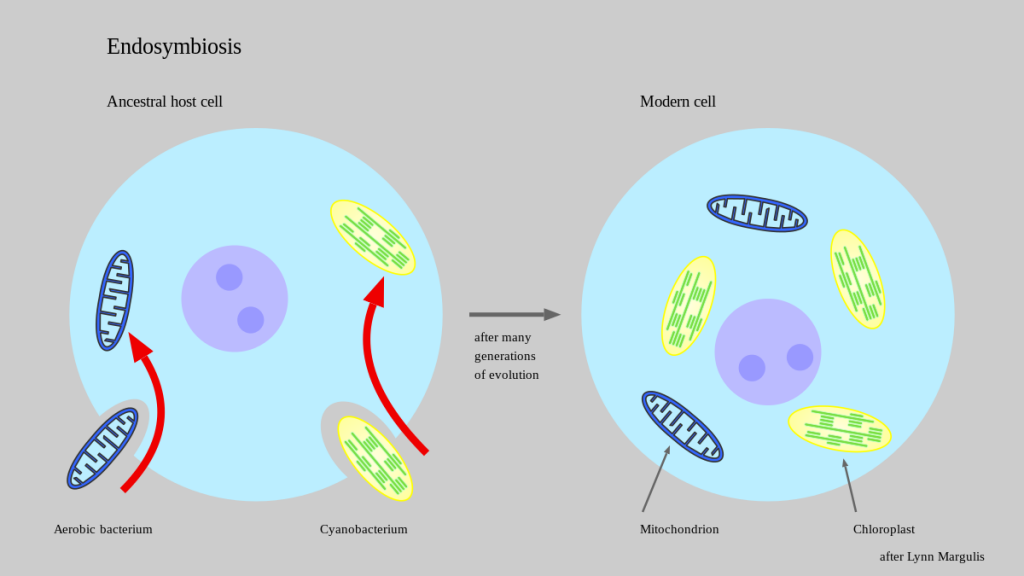
Ecology
Let’s now learn about the ecological importance and role of cyanobacteria.
-
Planktonic Cyanobacteria
Cyanobacteria are part of the phytoplankton together with the microalgae, such as diatoms, dinoflagellates, and green algae. The phytoplankton is vital to any aquatic ecosystem primarily due to their photosynthetic activity and for being one of the primary producers. The phytoplankton is an essential food source — from the tiniest organisms (zooplankton) to the largest animals on Earth, the blue whales.
-
Cyanobacterial blooms
Cyanobacteria are found in aquatic ecosystems, such as marine environments and moist soil. When the conditions are favorable, they grow exponentially. This phenomenon is called algal blooms.
Algal blooms occur especially in aquatic environments that are warm, stagnant or slowly flowing as these areas tend to accumulate high concentrations of blue-green algal nutrients like phosphorus and nitrogen. Nevertheless, the reproductive exponential growth of cyanobacteria resulting in an algal bloom can occur not just in freshwater but also in marine environments. Marine and freshwater cyanobacterial blooms are scum-like and blue-green in color.
Water samples of algal bloom sites indicate that the most common cyanobacterial genera are Microcystis, Anabaena (Dolichospermum ), and Planktothrix. (EPA.gov, 2018)
Cyanobacteria produce toxic secondary metabolites, cyanotoxins, which they release into the environment, especially during cyanobacterial cell death and lysis. (EPA.gov, 2018) These algal toxins can poison fish and other animals. Hence, as the cyanobacterial population rises, the level of cyanotoxin production also increases.
Note it!
Why do cyanobacteria produce toxins? Cyanobacteria may have used these toxins as a chemical defense against grazers and other microbes.
Cyanotoxins consist of neurotoxins, hepatotoxins, and dermatoxins that can impair respectively the nervous system, liver, and skin of animals and humans that ingest them, e.g., by drinking water containing a high concentration of cyanotoxin or by feeding on contaminated shellfish. Examples of common cyanotoxins in the U.S. are microsystins, cylindrospermopsin, anatoxins, and saxitoxins. (EPA.gov, 2018)
Spirulina sp., a filamentous species, however, is grown because of therapeutic claims on human health and its high nutritional content, such as calcium, iron, magnesium, potassium, sodium, and essential amino acids. Spirulina spp. are grown and harvested for consumption as human and animal dietary supplements. However, in the wild, they are at risk of heavy metal contamination. (Cox & Hickok, 2022)
Cyanobacterial bloom is also induced by mass cultivation for bioremediation, and biofuel production. The cultivation of genetically-engineered cyanobacteria is eyed seeking to reap the potential benefits of beneficial cyanobacteria to the general human health, agriculture, and economy.
Note it!
Cyanobacterial blooms are intensified by anthropogenic eutrophication of aquatic habitats. Rising temperatures, vertical stratification, increased carbon dioxide in the atmosphere, and high concentrations of phosphorus in eutrophic lakes and oceans can cause a cyanobacterial population to grow exponentially.
Watch this vid about cyanobacteria producing toxins and cyanobacteria blooms:
-
Nitrogen fixation
Heterocystous cyanobacteria develop heterocysts, the specialized cells that carry out nitrogen fixation. Nitrogen-fixing cyanobacteria can fix the atmospheric nitrogen into another form (e.g. ammonia, nitrites, or nitrates) that other living cells and organisms (e.g. plants and animals) can readily use and convert into proteins and nucleic acids. Thus, they may form a symbiosis with other organisms.
Anabaena sp. is an example of a cyanobacterial species that fix nitrogen. In the Anabaena colony, some cells of the colony transform into heterocysts. Anabaena cells may develop symbiosis with the water fern Azolla. Inside the host cell of Azolla, they form a colony and develop heterocysts that fix atmospheric nitrogen for their host.
Nitrogen-fixing cyanobacteria are grown in rice paddies as alternative nitrogen fertilizers as opposed to chemical nitrogen fertilizers.
-
Soil stabilization
In terrestrial habitats, such as damp soil, cyanobacteria help stabilize the soil. Their growth prevents erosion. They help retain water. For instance, Microcoleus vaginatus is a cyanobacterium that produces a polysaccharide sheath that binds soil particles and helps retain water. (Belnap & Gardner, 1993)
-
Oxygen cycle contributor
Cyanobacteria are key players in the oxygen cycle. Prochlorococcus sp. alone is credited for contributing much oxygen (about half) as they perform oxygenic photosynthesis in the open ocean. (Nadis, 2003)
-
Heterotrophy
Some cyanobacteria can become heterotrophs. Some heterotrophic parasitic cyanobacteria can cause disease to their invertebrate host, such as black band disease. (Kristiansen, 1964)
Take the Cyanobacteria Biology Quiz!
References
- Baumgartner RJ, et al. (2019). “Nano-porous pyrite and organic matter in 3.5-billion-year-old stromatolites record primordial life”. Geology. 47 (11): 1039–43.
- Pascher, A. (1914). “Über Flagellaten und Algen “. Berichte der deutsche botanischen Gesellschaft 32: 136–160.
- The NCBI taxonomy database. Retrieved from http://www.ncbi.nlm.nih.gov/taxonomy.
- Long, B. M., Badger, M. R., Whitney, S. M., & Price, G. D. (October 2007). “Analysis of carboxysomes from Synechococcus PCC7942 reveals multiple Rubisco complexes with carboxysomal proteins CcmM and CcaA”. The Journal of Biological Chemistry. 282 (40): 29323–35. doi:10.1074/jbc.M703896200.
- Armstronf, J. E. (2015). How the Earth Turned Green: A Brief 3.8-Billion-Year History of Plants. The University of Chicago Press. Retrieved from https://www.press.uchicago.edu/ucp/books/book/chicago/H/bo16465693.html
- Belnap, J. & Gardner, J. S. (1993). “Soil Microstructure in Soils of the Colorado Plateau: The Role of the Cyanobacterium Microcoleus Vaginatus”. The Great Basin Naturalist. 53 (1): 40–47.
- Nadis, S (December 2003). “The cells that rule the seas” (PDF). Scientific American. 289 (6): 52–3. Bibcode:2003SciAm.289f..52N. doi:10.1038/scientificamerican1203-52.
- Kristiansen, A. (1964). “Sarcinastrum urosporae, a Colourless Parasitic Blue-green Alga” (PDF). Phycologia. 4 (1): 19–22. doi:10.2216/i0031-8884-4-1-19.1.
- Cox, L., & Hickok, K. (2022, August 26). Spirulina: Uses, potential health benefits and risks. Livescience.com; Live Science. https://www.livescience.com/48853-spirulina-supplement-facts.html
- EPA.gov. (2018). Learn about Cyanobacteria and Cyanotoxins | US EPA. (2018, June 6). US EPA. https://www.epa.gov/cyanohabs/learn-about-cyanobacteria-and-cyanotoxins
© Biology Online. Content provided and moderated by Biology Online Editors

